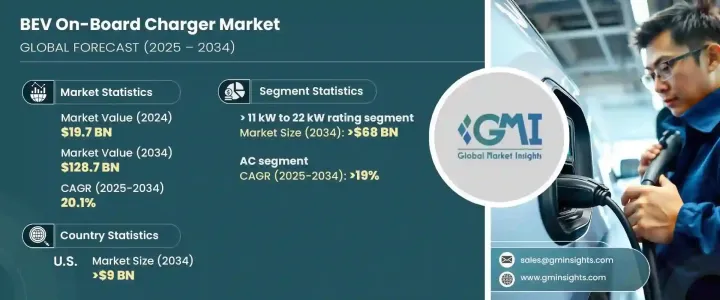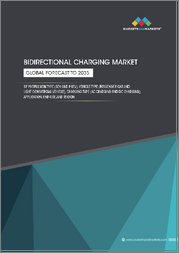
|
시장보고서
상품코드
1685114
BEV 온보드 차저 시장 기회, 성장 촉진요인, 산업 동향 분석, 예측(2025-2034년)BEV On-Board Charger Market Opportunity, Growth Drivers, Industry Trend Analysis, and Forecast 2025 - 2034 |
||||||
세계의 BEV 온보드 차저 시장은 2024년에 197억 달러에 달했고, 2025년부터 2034년에 걸쳐 CAGR 20.1%를 나타내 이례적인 고성장이 전망되고 있습니다.
세계 전기자동차(EV)의 증가와 지속가능한 에너지 솔루션으로의 변화 증가는 이러한 수요 급증의 원동력이 되고 있습니다. 소비자가 전기 이동성을 점점 더 받아들일수록, 더 빠르고 효율적인 충전 시스템이 시급해지고 있습니다. 이러한 상황의 변화는 제조업체 각사가 보다 높은 정격 출력을 가지는 온보드 차저를 혁신적으로 제조하도록 촉구하고, 충전 시간을 대폭 단축하고, 사용자 만족도를 높이고 있습니다. 청정 에너지 기술로의 전환이 가속화되어 EV는 환경 의식이 높은 운전자에게 선호되는 옵션이 되었으며, 그 결과 편리성과 대기 시간 단축을 실현하는 고급 충전 인프라와 온보드 차저 기술의 요구가 가속화되고 있습니다.

시장의 주요 부문 중 정격 출력 11kW-22kW의 BEV 온보드 차저는 2034년까지 680억 달러 시장 규모에 이를 것으로 예측되고 있습니다. 전기자동차의 소유자가 보다 신속한 충전 솔루션을 요구하고 있기 때문에 이 부문은 급성장할 것으로 예상됩니다. 제조업체는 보다 높은 출력을 제공하는 차저를 개발하는 것으로 대응하고 있어, 이것에 의해 자동차는 보다 빨리 충전할 수 있게 되어, 효율적이고 번거로운 충전 체험을 요구하는 소비자의 요구의 고조에 응하고 있습니다. 이러한 고출력 충전 시스템으로의 이동은 EV의 보급과 충전 인프라 확대의 세계 동향과 일치하여 BEV 시장이 상승 기조를 유지할 수 있도록 합니다.
| 시장 규모 | |
|---|---|
| 시작 연도 | 2024년 |
| 예측 연도 | 2025-2034년 |
| 시작 금액 | 197억 달러 |
| 예측 금액 | 1,287억 달러 |
| CAGR | 20.1% |
또 다른 큰 동향은 AC EV 온보드 차저의 대두이며, 2034년까지의 CAGR은 19%를 나타낼 것으로 예측되고 있습니다. 주거 지역과 상업 지역 모두에서 EV 충전 인프라 개발이 진행되고 있다는 것이 이러한 성장을 지원합니다. AC 차저는 비용 효율적이고 널리 보급되기 때문에 가정 및 공공 충전소에서 전기자동차를 충전하려는 소비자의 접근성이 높아지고 있습니다. 공공 및 민간 충전 네트워크의 확대에 상당한 투자가 이루어지고 있기 때문에 AC 온보드 차저 수요는 꾸준히 증가하고 시장 전체의 성장에 기여하고 있습니다.
미국의 BEV 온보드 차저 시장은 2034년까지 90억 달러에 달할 것으로 예상됩니다. 이 나라에서는 전기자동차의 보급이 진행되고 있으며, 보다 빠르고 효율적인 충전 솔루션에 대한 수요가 높아지고 있는 것이 이 시장을 견인하고 있습니다. 제조업체는 보다 짧은 충전 시간에 대한 소비자의 기대에 부응하기 위해 11kW-22kW 차저의 생산에 주력하고 있습니다. 충전 프로세스를 더욱 원활하게 하고 다른 EV 모델과 차저 간의 상호 운용성을 높이는 것을 목표로 충전 프로토콜의 표준화에 대한 노력도 진행되고 있습니다. 유리한 정부 정책에 의해 지원되는 충전 인프라의 확대는 미국 시장과 그 성장 가능성을 더욱 뒷받침하고 있습니다.
목차
제1장 조사 방법과 조사 범위
- 시장 범위와 정의
- 시장 추계·예측 파라미터
- 예측 계산
- 데이터 소스
- 1차 데이터
- 2차 데이터
- 유료
- 공적
제2장 주요 요약
제3장 업계 인사이트
- 생태계 분석
- 규제 상황
- 업계에 미치는 영향요인
- 성장 촉진요인
- 업계의 잠재적 위험 및 과제
- 성장 가능성 분석
- Porter's Five Forces 분석
- PESTEL 분석
제4장 경쟁 구도
- 서론
- 전략적 전망
- 혁신 및 지속가능성의 전망
제5장 시장 규모와 예측 : 정격별(2021-2034년)
- 주요 동향
- 11 kW 미만
- 11 kW-22 kW
- 22 kW 이상
제6장 시장 규모와 예측 : 전류별(2021-2034년)
- 주요 동향
- AC
- DC
제7장 시장 규모와 예측 : 지역별(2021-2034년)
- 주요 동향
- 북미
- 미국
- 캐나다
- 멕시코
- 유럽
- 노르웨이
- 독일
- 프랑스
- 네덜란드
- 영국
- 스웨덴
- 아시아태평양
- 중국
- 일본
- 인도
- 한국
- 호주
- 중동 및 아프리카
- 사우디아라비아
- 아랍에미리트(UAE)
- 남아프리카
- 라틴아메리카
- 브라질
- 아르헨티나
제8장 기업 프로파일
- Bel Fuse
- BorgWarner
- Brusa Elektronik
- Delta Energy Systems
- Eaton
- Ficosa Internacional
- Hyundai Motor
- Infineon Technologies
- Innolectric
- Nissan Motor
- Phinia
- Stercom Power Solutions
- STMicroelectronics
- Tesla
- Toyota Industries
- Valeo
- Xepics Italia
The Global BEV On-Board Charger Market reached USD 19.7 billion in 2024 and is expected to expand at an exceptional CAGR of 20.1% from 2025 to 2034. The rise of electric vehicles (EVs) worldwide, coupled with the growing shift towards sustainable energy solutions, is driving this surge in demand. As consumers increasingly embrace electric mobility, there is an urgent need for faster and more efficient charging systems. This evolving landscape is encouraging manufacturers to innovate and produce on-board chargers with higher power ratings, reducing charging times significantly and enhancing user satisfaction. The accelerated shift to clean energy technologies is making EVs a preferred choice for eco-conscious drivers, which, in turn, accelerates the need for advanced charging infrastructure and on-board charger technologies that deliver convenience and reduced waiting times.

Among the key segments of the market, the BEV on-board chargers with power ratings ranging from 11 kW to 22 kW are projected to generate USD 68 billion by 2034. As electric vehicle owners demand quicker charging solutions, this segment is expected to grow rapidly. Manufacturers are responding by developing chargers that offer higher power outputs, allowing vehicles to charge faster and meet the growing needs of consumers who seek efficient, hassle-free charging experiences. This shift towards high-power charging systems aligns with global trends in EV adoption and charging infrastructure expansion, ensuring that the BEV market remains on an upward trajectory.
| Market Scope | |
|---|---|
| Start Year | 2024 |
| Forecast Year | 2025-2034 |
| Start Value | $19.7 Billion |
| Forecast Value | $128.7 Billion |
| CAGR | 20.1% |
Another significant trend is the rise of AC (alternating current) EV on-board chargers, which are anticipated to experience a CAGR of 19% through 2034. The increasing development of EV charging infrastructure in both residential and commercial areas is supporting this growth. AC chargers are cost-effective, and their widespread availability is enhancing accessibility for consumers looking to charge their electric vehicles at home or public charging stations. With significant investments being made in the expansion of both public and private charging networks, the demand for AC on-board chargers is steadily increasing, contributing to the market's overall growth.
The U.S. market for BEV on-board chargers is expected to generate USD 9 billion by 2034. The country's increasing adoption of electric vehicles, along with a growing demand for faster and more efficient charging solutions, is driving this market forward. Manufacturers are focusing on producing chargers within the 11 kW to 22 kW range to meet consumer expectations for quicker charge times. Efforts to standardize charging protocols are also underway, aiming to make the charging process more seamless and enhance interoperability between different EV models and chargers. The expansion of charging infrastructure, supported by favorable government policies, is further boosting the U.S. market and its growth potential.
Table of Contents
Chapter 1 Methodology & Scope
- 1.1 Market scope & definitions
- 1.2 Market estimates & forecast parameters
- 1.3 Forecast calculation
- 1.4 Data sources
- 1.4.1 Primary
- 1.4.2 Secondary
- 1.4.2.1 Paid
- 1.4.2.2 Public
Chapter 2 Executive Summary
- 2.1 Industry synopsis, 2021 - 2034
Chapter 3 Industry Insights
- 3.1 Industry ecosystem analysis
- 3.2 Regulatory landscape
- 3.3 Industry impact forces
- 3.3.1 Growth drivers
- 3.3.2 Industry pitfalls & challenges
- 3.4 Growth potential analysis
- 3.5 Porter's analysis
- 3.5.1 Bargaining power of suppliers
- 3.5.2 Bargaining power of buyers
- 3.5.3 Threat of new entrants
- 3.5.4 Threat of substitutes
- 3.6 PESTEL analysis
Chapter 4 Competitive Landscape, 2024
- 4.1 Introduction
- 4.2 Strategic outlook
- 4.3 Innovation & sustainability landscape
Chapter 5 Market Size and Forecast, By Rating, 2021 – 2034 (Units, USD Billion)
- 5.1 Key trends
- 5.2 < 11 kW
- 5.3 > 11 kW to 22 kW
- 5.4 > 22 kW
Chapter 6 Market Size and Forecast, By Current, 2021 – 2034 (Units, USD Billion)
- 6.1 Key trends
- 6.2 AC
- 6.3 DC
Chapter 7 Market Size and Forecast, By Region, 2021 – 2034 (Units, USD Billion)
- 7.1 Key trends
- 7.2 North America
- 7.2.1 U.S.
- 7.2.2 Canada
- 7.2.3 Mexico
- 7.3 Europe
- 7.3.1 Norway
- 7.3.2 Germany
- 7.3.3 France
- 7.3.4 Netherlands
- 7.3.5 UK
- 7.3.6 Sweden
- 7.4 Asia Pacific
- 7.4.1 China
- 7.4.2 Japan
- 7.4.3 India
- 7.4.4 South Korea
- 7.4.5 Australia
- 7.5 Middle East & Africa
- 7.5.1 Saudi Arabia
- 7.5.2 UAE
- 7.5.3 South Africa
- 7.6 Latin America
- 7.6.1 Brazil
- 7.6.2 Argentina
Chapter 8 Company Profiles
- 8.1 Bel Fuse
- 8.2 BorgWarner
- 8.3 Brusa Elektronik
- 8.4 Delta Energy Systems
- 8.5 Eaton
- 8.6 Ficosa Internacional
- 8.7 Hyundai Motor
- 8.8 Infineon Technologies
- 8.9 Innolectric
- 8.10 Nissan Motor
- 8.11 Phinia
- 8.12 Stercom Power Solutions
- 8.13 STMicroelectronics
- 8.14 Tesla
- 8.15 Toyota Industries
- 8.16 Valeo
- 8.17 Xepics Italia



















